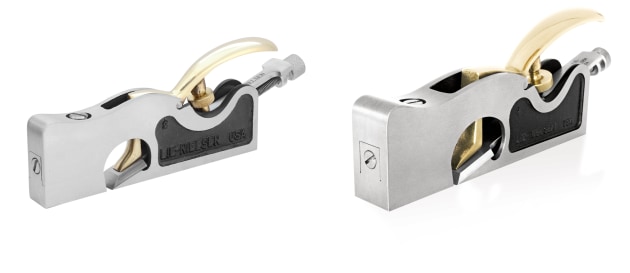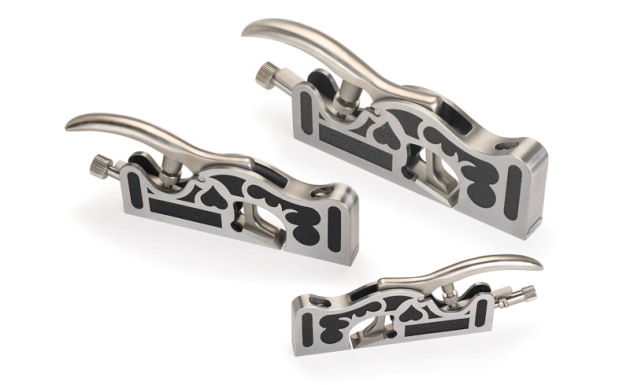Shoulder to shoulder: planes compared
Words: Raf Nathan
After a smoothing plane and block plane, a good shoulder plane should be on most woodworkers’ tool lists. These planes are great for planing the shoulders (hence the name) of tenons and will plane with the grain as well. Use them for cleaning up grooves or planing in tricky situations.
The blades on these run the full width of the body, in fact they extend a fraction beyond the body for planing right up to the edge of a workpiece. The blade must always be ground square or they won’t work well. The sides and base need to be ground at 90°. That is why better quality planes are more expensive. Lower priced planes may need ‘tuning’, that is, squaring up the sides and preparing the blade. Better planes also have good depth adjustment mechanisms.
These planes are very good on endgrain, given the low bed angle which usually comes with a bevel-up blade. I say usually because whilst most shoulder planes are bevel-up the Hock plane kit and HNT Gordon planes run with a bevel down blade, giving them a different action. Blade depth adjustment is usually by a knob but on these two brands you tap the blade with a small hammer to the desired position.
Most shoulder planes are based on the famous Preston planes of the UK. Preston no longer operate, but left a design legacy adopted by Lie-Nielsen, WoodRiver and Clifton.
The width of the blade, usually measured in inches, is how these planes are sized. All makers have their own tool steels and it‘s an arcane world of naming, with blades defined as A2, PM- V11, O1 and simply ‘tool steel’.
Bigger is not always best in plane sizes. I base this observation on the premise you can plane large work with a small plane but can’t always plane small work with a large plane. In other words a medium or small plane is better for general wood jobs in the shed. The very small shoulder planes are very cute to behold and use, and are great for small work and cleaning out grooves.
Lie-Nielsen, it is fair to say, set the standard years ago in modern Preston style design shoulder planes. They
are beautifully made tools with fine attention to detail. The polished bronze cap iron is a very nice touch, as is the adjustable toe. The models shown here illustrate some of the options available.
* Prices quoted throughout were correct at time of writing.
In the British Tradition
Clifton are the only production plane maker left in the UK but pride themselves on maintaining the tradition of British toolmaking. They make four different shoulder planes and we picked out these two as desirable users. The Clifton 400 (above left) is based on a Preston rebate plane and has an 11mm wide blade and a rosewood wedge. It’s a great small plane for tight areas or small work. Sells locally for around $200. The Clifton 410 on the right is machined from grey iron casting and is precision ground on the sole and the sides. A great sized plane for general woodworking with plenty of heft at nearly 0.6kg. This one costs $310. Images courtesy Thomas Flinn & Co
Available from www.beyondtools.com.au
In Many Sizes
Veritas make shoulder planes in five sizes: from a miniature plane with a 1/4" (6.35mm) wide blade, up to a larger one with a 32mm wide blade. The two larger Veritas planes have adjusting handles for using with the tool on its side. All but the miniature plane have an adjustable toe and four embedded set-screws along the body so the blade, once set, always lines up square when replacing it after sharpening. Blades are 3.2mm thick with the option of their own secret PM-V11 blade steel technology. One of our favourites is the small model (second from the right above) with 12.7mm wide blade with its comfortable slim handle.
Above on the left, the large model at 1.7kg is the tool for serious cabinetmaking. This is a relatively new design with a different lever cap, plus the extras of two adjustable wood handles. It sells for $439. On the far right, the small bullnose plane ($349) with a 1" wide blade weighs half a kilo and packs a punch way above its weight, so to speak. It also has a removable toe so it can work as chisel plane. Image supplied courtesy Lee Valley Tools.
Available from www.carbatec.com.au
Setting Standards
Shown above here on the left, the Lie-Nielsen #041 has a 5/8" blade, weighs 0.6kg and currently sells for $549. The large #073 is based on the Record 073 and original Preston planes. It has a 1-1/4" blade, weighs 1.8kg, $699. This is one to get if you need a full size plane. They also make a 3/4" plane. All have 3.5mm thick blades. You have to have at least one Lie-Nielsen in your tool cabinet. Any of the above are a good choice. Images courtesy Lie-Nielsen Australia.
Fully Adjustable
There are three sizes in the WoodRiver range of shoulder planes. We like the No. 92. This handsome 3/4" plane is proudly based on the original Preston design, but with an improvement of an adjustable toe. The body is stress-relieved ductile steel and the finish and detailing is very good. Images courtesy Professional Woodwork Supplies.

Make Your Own
Hock Tools shoulder plane kit is for a plane you make yourself from pre-machined beech and bubinga components. It comes with a genuine Hock blade that is 3/4" wide and a generous 4mm thick. This is a 37.5° bevel-down plane. Our experience of Hock blades is great; they are tough and yet hold the edge well. You can make one of these planes with just a drill and clamps as the main tools. Currently $193 from Professional Woodwork Supplies. Images courtesy PWS.
Versatile in Wood
Locally made HNT Gordon shoulder planes range from 1/2" ($324) to 3/4" ($348), 1" ($366) and 1–1/4" ($414). Made from Australian gidgee, and sometimes in other select woods, the blade sits bevel-down. It has a 60° blade angle or acts as a 90° scraper when you reverse the blade to bevel-up to handle difficult grain. The 1" model is our favourite as a good all-round size. The planes are a minimalist design and have an attractive air of handmade about them (which they are). The 4.7mm thick blade certainly adds to the mass with the plane weighing 0.8kg. Image courtesy HNT Gordon.
Raf Nathan is a woodwork designer maker and regular contributor to Wood Review magazine.






